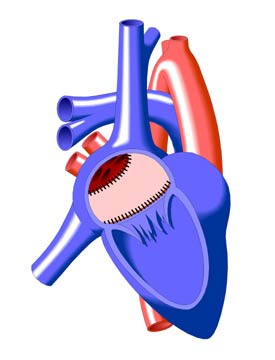
The Mustard Procedure |
|
Arrhythmias and the Mustard and Senning Procedure
Arrhythmias after the Mustard and Senning procedures are often caused by the modification of cardiac tissue during the operation and subsequent scarring. (The Mustard and Senning procedures, for treatment of Transposition of the Great Arteries, are identical except that the baffle is constructed from atrial tissue in the Senning and from pericardium in the Mustard.)
In some cases, damage to the heart's natural pacemaker, the sinoatrial node, may result in a gradual deterioration of the heart's rhythm. As many as two-thirds of adult Mustard or Senning patients will eventually develop arrhythmias.
Conduction problems may arise when the right ventricle, which is the main pumping chamber in the Mustard or Senning patient (as opposed to the left ventricle in the normal heart), begins to lose its ability to cope with the job of supplying blood to the body's tissues. With increasing right ventricular dysfunction, ventricular arrhythmias may develop, which may lead to congestive heart failure and the risk of sudden death.
Treatment of post-Mustard/Senning arrhythmias may involve medications, the insertion of pacemakers or ICDs (implantable cardioverter defibrillators, which will shock the heart to restore normal rhythm if necessary), and radiofrequency ablations (non-surgical procedures in which the heart tissue that is causing the arrhythmia is neutralized). |
|